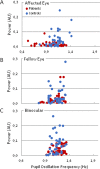A novel method of inducing endogenous pupil oscillations to detect patients with unilateral optic neuritis
- PMID: 30133485
- PMCID: PMC6104938
- DOI: 10.1371/journal.pone.0201730
A novel method of inducing endogenous pupil oscillations to detect patients with unilateral optic neuritis
Abstract
Purpose: To use and test a new method of inducing endogenously generated pupillary oscillations (POs) in patients with unilateral optic neuritis (ON), to describe a signal analysis approach quantifying pupil activity and to evaluate the extent to which POs permit to discriminate patients from control participants.
Method: Pupil size was recorded with an eye-tracker and converted in real time to modulate the luminance of a stimulus (a 20° disk) presented in front of participants. With this biofeedback setting, an increasing pupil size transforms into a high luminance, entraining a pupil constriction that in turn decreases the stimulus luminance, and so on, resulting in endogenously generated POs. POs were recorded for 30 seconds in the affected eye, in the fellow eye and in binocular conditions with 22 patients having a history of unilateral ON within a period of 5 years, and with 22 control participants. Different signal analysis methods were used to quantify the power and frequency of POs.
Results: On average, pupil size oscillated at around 1 Hz. The amplitude of POs appears not to be a reliable marker of ON. In contrast, the frequency of POs was significantly lower, and was more variable over time, in the patients' affected eye, as compared to their fellow eye and to the binocular condition. No such differences were found in control participants. Receiver operating characteristic analyses based on the frequency and the variability of POs to classify patients and control participants gave an area under the curve of 0.82, a sensitivity of 82% (95%CI: 60%-95%) and a specificity of 77% (95%CI: 55%-92%).
Conclusions: The new method used to induce POs allowed characterizing the visual afferent pathway defect in ON patients with encouraging accuracy. The method was fast, easy to use, only requiring that participants look ahead, and allows testing many stimulus parameters (e.g. color, stimulus location, size, etc).
Conflict of interest statement
The authors have declared that no competing interests exist.
Figures








References
-
- Loewenfeld I. The pupil: Anatomy, physiology, and clinical applications. Boston, MA: Butterworth-Heinemann; 1999.
-
- Kardon R. Anatomy and physiology of the Autonomic Nervous System Walsh & Hoyt’s Clinical Neuro-Ophthalmology. 6th ed. Philadelphia, PA: Lippincott Williams & Wilkins; 2005. pp. 649–714.
Publication types
MeSH terms
LinkOut - more resources
Full Text Sources
Other Literature Sources
Miscellaneous

